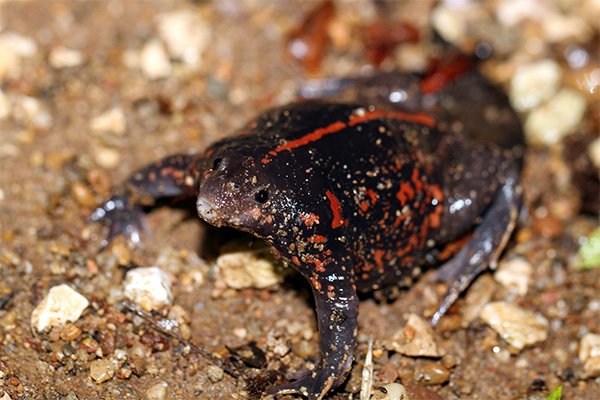The Underground Hermit
William L. Farr, CC BY-SA 4.0, via Wikimedia Commons
Rhinophrynidae
by Inspector Barry Mins on October 4, 2022Hey kids, welcome back to our series on the mysteries of created kinds.
This week, we move from the Middle East to Central America and from birds to amphibians. To find this species, we need to go underground. It likes to burrow.

This kind only has one living species, though several more are known from fossils. It prefers tropical rain forests and scrub as its home but stays burrowed for much of the year.1 Its preferred meals are ants and termites, which it hunts largely below the surface.2 It only emerges from its burrows to breed. The body has loose skin that can be inflated to repel predators.
Breeding in this kind occurs during the rainy season, and males and females are of roughly the same size.3 When tadpoles hatch, they form aggregates of similarly sized individuals that appear to influence both adult size and social behavior.4 Larger tadpoles will sometimes eat their smaller relatives, but in pools containing sometimes hundreds of thousands of tadpoles, these events are unlikely to significantly impact the population.5
Has anyone figured it out yet? Don’t feel bad if you didn’t, there is not a lot of work out there on this kind because it spends so much time underground. This week’s kind is the Rhinophrynidae—the Mexican burrowing toad kind. Stay tuned for next week when we head to a pond to look for yet another monotypic kind.

Burrowing Toad
Greg Schechter from San Francisco, USA, via Wikimedia Commons
Try out this fun word search!
Clue
Your clue for the week is:
This species of bird is found only in Australia and builds large nests in the crowns of trees.
Ask a Question
Have you ever had a question about created kinds but didn’t know who to ask? Have you ever wanted to learn more about your favorite kind? Well, now you can! You can ask me, Inspector Barry Mins, a question! Have your parents help you fill out this form, and you might get your question answered in my column! If you have any questions about created kinds, feel free to send them my way!
Footnotes
- W. E. Duellman, “The burrowing toad: Rhinophrynus dorsalis, on the Caribbean Lowlands of Central America,” Herpetologia 27, no. 1 (1971): 55–56.
- L. Trueb and C. Gans, “Feeding specializations of the Mexican burrowing toad, Rhinophrynus dorsalis (Anura: Rhinophrynidae),” Journal of the Zoological Society of London, 199 (1983): 189–208.
- D. F. Hughes and D. B Wylie, “Reproductive ecology of Rhinophrynus dorsalis (Anura: Rhinophrynidae) in México,” Journal of Herpetology 55, no. 3 (2021): 298–309.
- M. S. Foster and R. W. McDiarmid, “Study of aggregative behavior of Rhinophrynus dorsalis tadpoles: design and analysis,” Herpetologia 38, no. 3 (1982): 395–404.
- J. L. Stynoski and M. Sasa, “Cannibalism by large tadpoles of Rhinophrynus dorsalis (Anura: Rhinophrynidae),” Herpetology Notes 11: 1047–1049.
- © 2024 Answers in Genesis
- Privacy Policy
- Contact
- About
